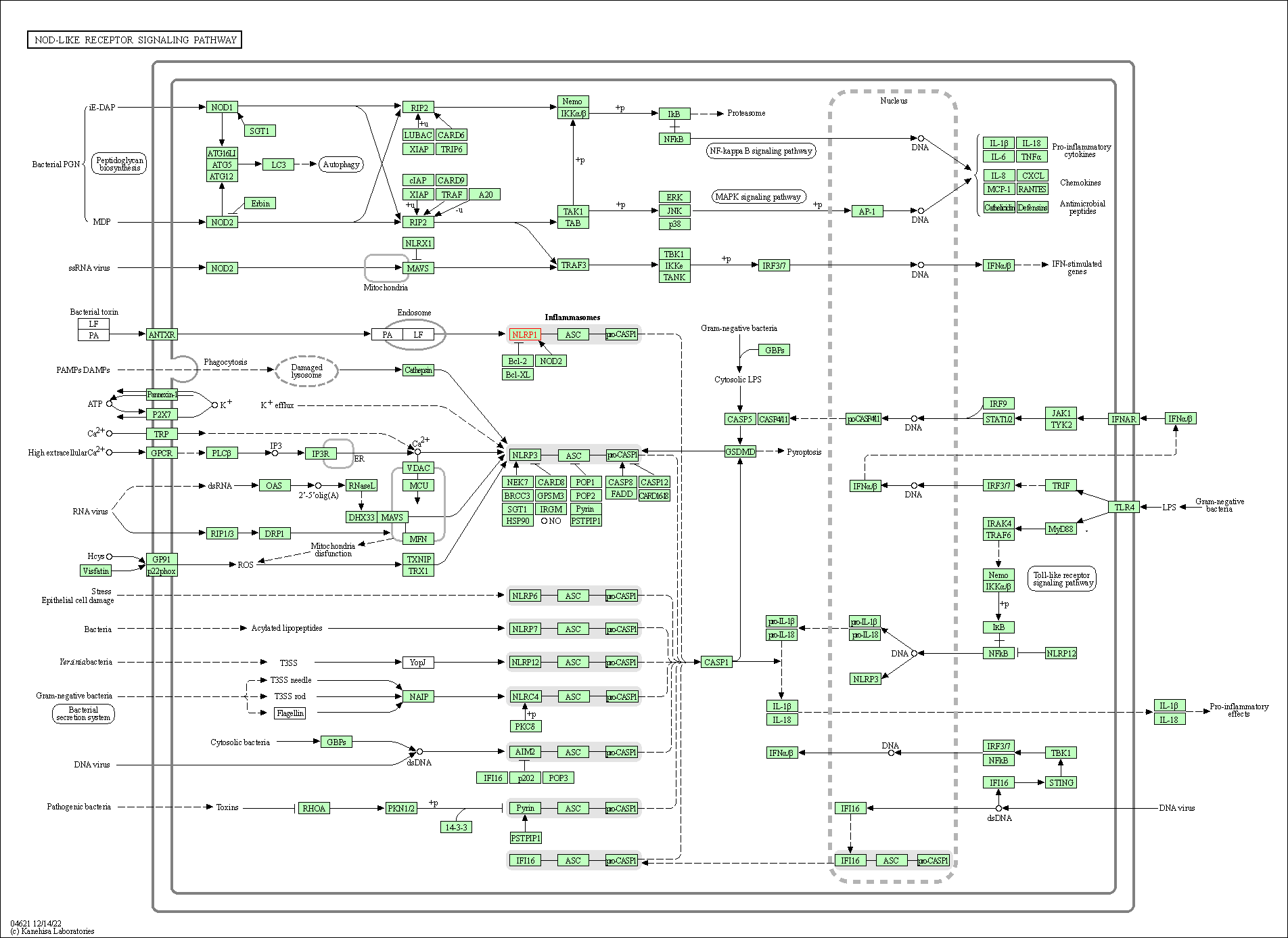Target Information
| Target General Information | Top | |||||
|---|---|---|---|---|---|---|
| Target ID |
T86910
(Former ID: TTDI03404)
|
|||||
| Target Name |
NLR pyrin domain containing 1 (NLRP1)
|
|||||
| Synonyms |
Nucleotide-binding domain and caspase recruitment domain; NACHT, LRR and PYD domains-containing protein 1; NAC; KIAA0926; Death effector filament-forming ced-4-like apoptosis protein; DEFCAP; Caspase recruitment domain-containing protein 7; CARD7
Click to Show/Hide
|
|||||
| Gene Name |
NLRP1
|
|||||
| Target Type |
Literature-reported target
|
[1] | ||||
| Function |
As the sensor component of the NLRP1 inflammasome, plays a crucial role in innate immunity and inflammation. In response to pathogens and other damage-associated signals, initiates the formation of the inflammasome polymeric complex, made of NLRP1, CASP1, and possibly PYCARD. Recruitment of proCASP1 to the inflammasome promotes its activation and CASP1-catalyzed IL1B and IL18 maturation and secretion in the extracellular milieu. Activation of NLRP1 inflammasome is also required for HMGB1 secretion. The active cytokines and HMGB1 stimulate inflammatory responses. Inflammasomes can also induce pyroptosis, an inflammatory form of programmed cell death. May be activated by muramyl dipeptide (MDP), a fragment of bacterial peptidoglycan, in a NOD2-dependent manner. Contrary to its mouse ortholog, not activated by Bacillus anthracis lethal toxin. It is unclear whether isoform 2 is involved in inflammasome formation. It is not cleaved within the FIIND domain, does not assemble into specks, nor promote IL1B release. However, in an vitro cell-free system, it has been shown to be activated by MDP. Binds ATP.
Click to Show/Hide
|
|||||
| UniProt ID | ||||||
| Sequence |
MAGGAWGRLACYLEFLKKEELKEFQLLLANKAHSRSSSGETPAQPEKTSGMEVASYLVAQ
YGEQRAWDLALHTWEQMGLRSLCAQAQEGAGHSPSFPYSPSEPHLGSPSQPTSTAVLMPW IHELPAGCTQGSERRVLRQLPDTSGRRWREISASLLYQALPSSPDHESPSQESPNAPTST AVLGSWGSPPQPSLAPREQEAPGTQWPLDETSGIYYTEIREREREKSEKGRPPWAAVVGT PPQAHTSLQPHHHPWEPSVRESLCSTWPWKNEDFNQKFTQLLLLQRPHPRSQDPLVKRSW PDYVEENRGHLIEIRDLFGPGLDTQEPRIVILQGAAGIGKSTLARQVKEAWGRGQLYGDR FQHVFYFSCRELAQSKVVSLAELIGKDGTATPAPIRQILSRPERLLFILDGVDEPGWVLQ EPSSELCLHWSQPQPADALLGSLLGKTILPEASFLITARTTALQNLIPSLEQARWVEVLG FSESSRKEYFYRYFTDERQAIRAFRLVKSNKELWALCLVPWVSWLACTCLMQQMKRKEKL TLTSKTTTTLCLHYLAQALQAQPLGPQLRDLCSLAAEGIWQKKTLFSPDDLRKHGLDGAI ISTFLKMGILQEHPIPLSYSFIHLCFQEFFAAMSYVLEDEKGRGKHSNCIIDLEKTLEAY GIHGLFGASTTRFLLGLLSDEGEREMENIFHCRLSQGRNLMQWVPSLQLLLQPHSLESLH CLYETRNKTFLTQVMAHFEEMGMCVETDMELLVCTFCIKFSRHVKKLQLIEGRQHRSTWS PTMVVLFRWVPVTDAYWQILFSVLKVTRNLKELDLSGNSLSHSAVKSLCKTLRRPRCLLE TLRLAGCGLTAEDCKDLAFGLRANQTLTELDLSFNVLTDAGAKHLCQRLRQPSCKLQRLQ LVSCGLTSDCCQDLASVLSASPSLKELDLQQNNLDDVGVRLLCEGLRHPACKLIRLGLDQ TTLSDEMRQELRALEQEKPQLLIFSRRKPSVMTPTEGLDTGEMSNSTSSLKRQRLGSERA ASHVAQANLKLLDVSKIFPIAEIAEESSPEVVPVELLCVPSPASQGDLHTKPLGTDDDFW GPTGPVATEVVDKEKNLYRVHFPVAGSYRWPNTGLCFVMREAVTVEIEFCVWDQFLGEIN PQHSWMVAGPLLDIKAEPGAVEAVHLPHFVALQGGHVDTSLFQMAHFKEEGMLLEKPARV ELHHIVLENPSFSPLGVLLKMIHNALRFIPVTSVVLLYHRVHPEEVTFHLYLIPSDCSIR KAIDDLEMKFQFVRIHKPPPLTPLYMGCRYTVSGSGSGMLEILPKELELCYRSPGEDQLF SEFYVGHLGSGIRLQVKDKKDETLVWEALVKPGDLMPATTLIPPARIAVPSPLDAPQLLH FVDQYREQLIARVTSVEVVLDKLHGQVLSQEQYERVLAENTRPSQMRKLFSLSQSWDRKC KDGLYQALKETHPHLIMELWEKGSKKGLLPLSS Click to Show/Hide
|
|||||
| 3D Structure | Click to Show 3D Structure of This Target | AlphaFold | ||||
| Cell-based Target Expression Variations | Top | |||||
|---|---|---|---|---|---|---|
| Cell-based Target Expression Variations | ||||||
| Different Human System Profiles of Target | Top |
|---|---|
|
Human Similarity Proteins
of target is determined by comparing the sequence similarity of all human proteins with the target based on BLAST. The similarity proteins for a target are defined as the proteins with E-value < 0.005 and outside the protein families of the target.
A target that has fewer human similarity proteins outside its family is commonly regarded to possess a greater capacity to avoid undesired interactions and thus increase the possibility of finding successful drugs
(Brief Bioinform, 21: 649-662, 2020).
Human Tissue Distribution
of target is determined from a proteomics study that quantified more than 12,000 genes across 32 normal human tissues. Tissue Specificity (TS) score was used to define the enrichment of target across tissues.
The distribution of targets among different tissues or organs need to be taken into consideration when assessing the target druggability, as it is generally accepted that the wider the target distribution, the greater the concern over potential adverse effects
(Nat Rev Drug Discov, 20: 64-81, 2021).
Human Pathway Affiliation
of target is determined by the life-essential pathways provided on KEGG database. The target-affiliated pathways were defined based on the following two criteria (a) the pathways of the studied target should be life-essential for both healthy individuals and patients, and (b) the studied target should occupy an upstream position in the pathways and therefore had the ability to regulate biological function.
Targets involved in a fewer pathways have greater likelihood to be successfully developed, while those associated with more human pathways increase the chance of undesirable interferences with other human processes
(Pharmacol Rev, 58: 259-279, 2006).
Biological Network Descriptors
of target is determined based on a human protein-protein interactions (PPI) network consisting of 9,309 proteins and 52,713 PPIs, which were with a high confidence score of ≥ 0.95 collected from STRING database.
The network properties of targets based on protein-protein interactions (PPIs) have been widely adopted for the assessment of target’s druggability. Proteins with high node degree tend to have a high impact on network function through multiple interactions, while proteins with high betweenness centrality are regarded to be central for communication in interaction networks and regulate the flow of signaling information
(Front Pharmacol, 9, 1245, 2018;
Curr Opin Struct Biol. 44:134-142, 2017).
Human Similarity Proteins
Human Tissue Distribution
Human Pathway Affiliation
Biological Network Descriptors
|
|
| Protein Name | Pfam ID | Percentage of Identity (%) | E value |
|---|---|---|---|
| Leucine-rich repeat-containing protein 73 (LRRC73) | 30.968 (48/155) | 4.00E-03 | |
|
Note:
If a protein has TS (tissue specficity) scores at least in one tissue >= 2.5, this protein is called tissue-enriched (including tissue-enriched-but-not-specific and tissue-specific). In the plots, the vertical lines are at thresholds 2.5 and 4.
|
| KEGG Pathway | Pathway ID | Affiliated Target | Pathway Map |
|---|---|---|---|
| NOD-like receptor signaling pathway | hsa04621 | Affiliated Target |

|
| Class: Organismal Systems => Immune system | Pathway Hierarchy | ||
| Degree | 5 | Degree centrality | 5.37E-04 | Betweenness centrality | 3.87E-05 |
|---|---|---|---|---|---|
| Closeness centrality | 2.07E-01 | Radiality | 1.36E+01 | Clustering coefficient | 4.00E-01 |
| Neighborhood connectivity | 1.88E+01 | Topological coefficient | 2.55E-01 | Eccentricity | 11 |
| Download | Click to Download the Full PPI Network of This Target | ||||
| References | Top | |||||
|---|---|---|---|---|---|---|
| REF 1 | URL: http://www.guidetopharmacology.org Nucleic Acids Res. 2015 Oct 12. pii: gkv1037. The IUPHAR/BPS Guide to PHARMACOLOGY in 2016: towards curated quantitative interactions between 1300 protein targets and 6000 ligands. (Target id: 1768). | |||||
If You Find Any Error in Data or Bug in Web Service, Please Kindly Report It to Dr. Zhou and Dr. Zhang.

